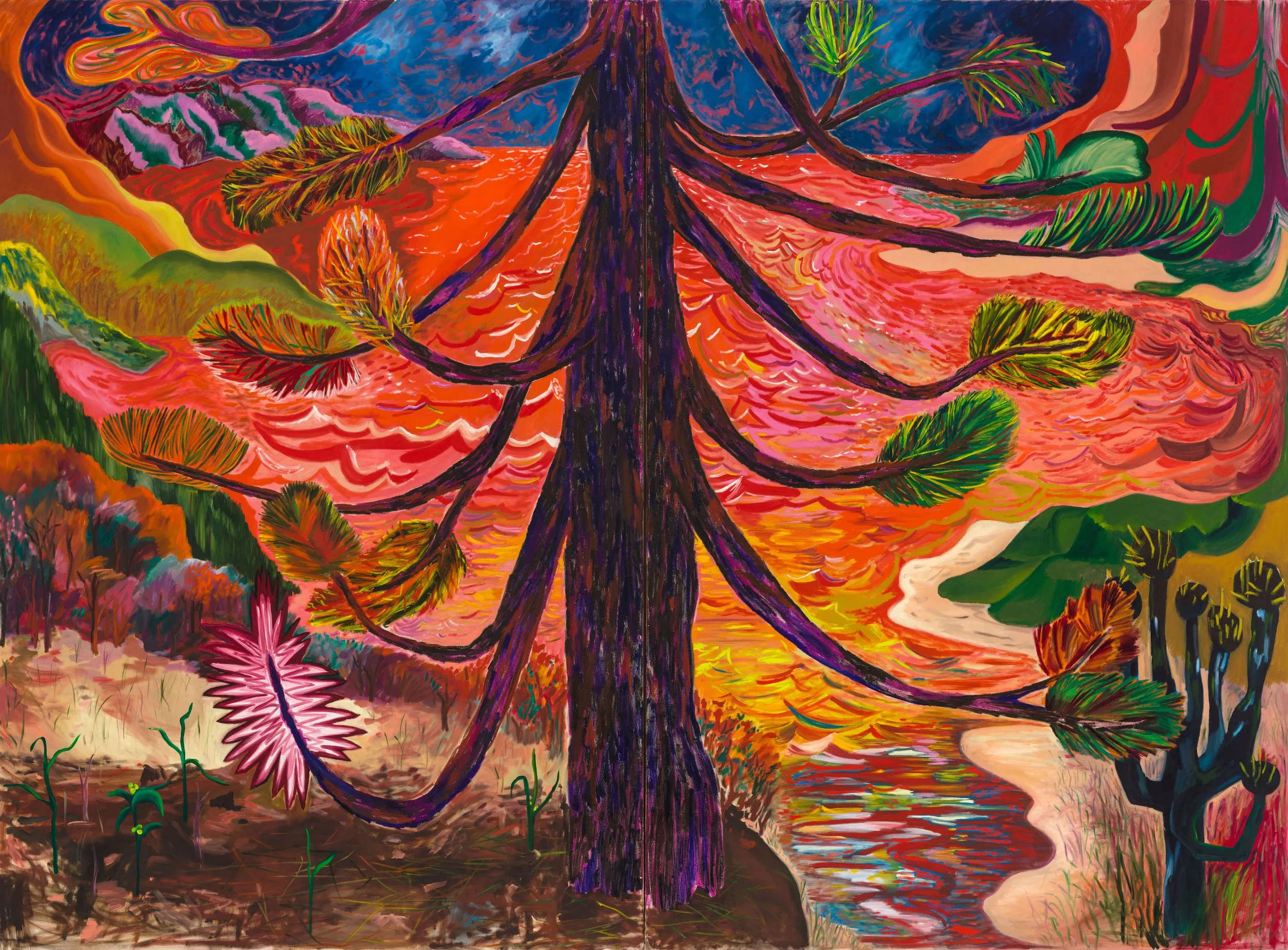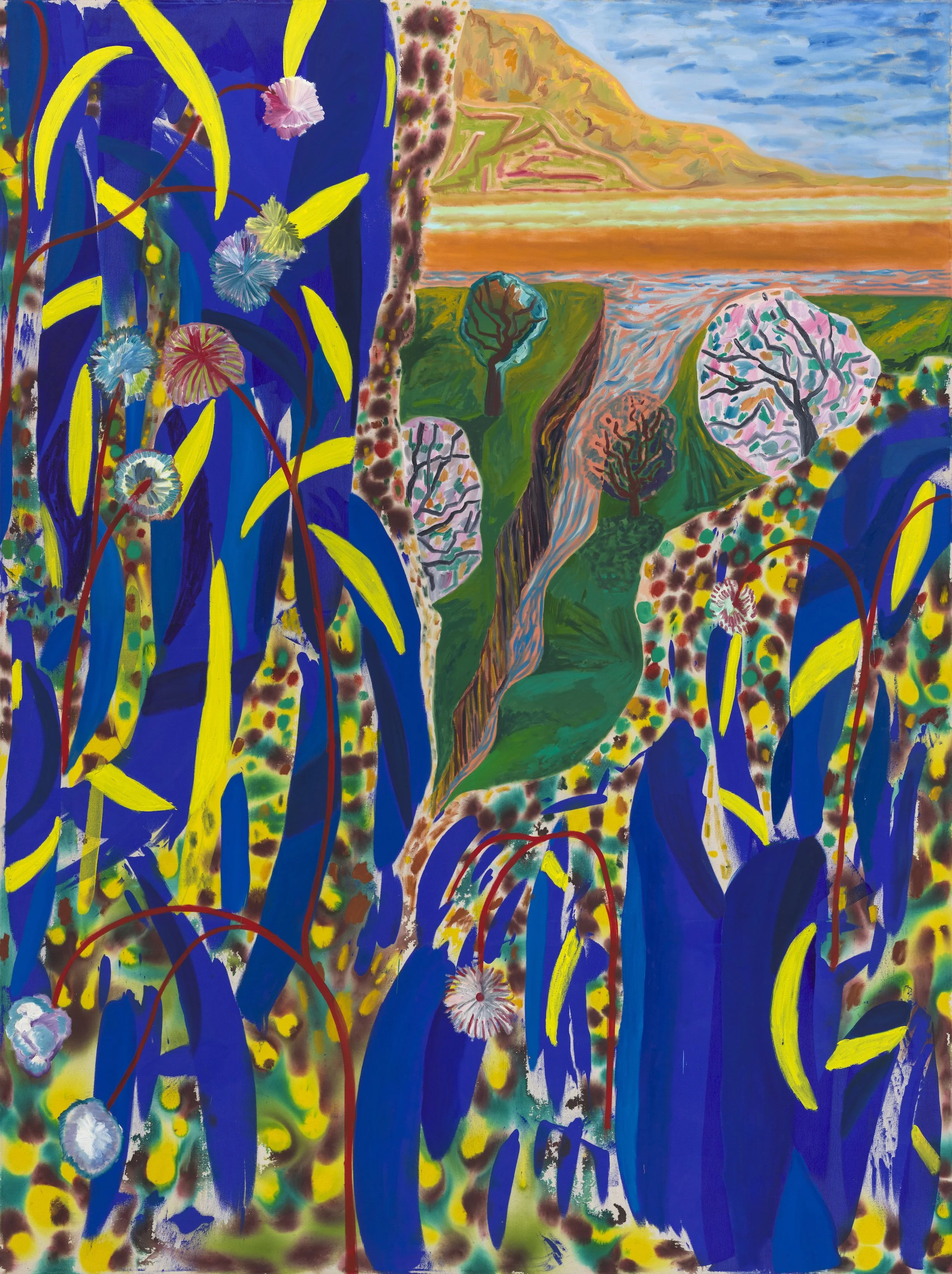Shara Hughes: ‘Right This Way’ by Alice Godwin
At the northernmost tip of Denmark there is a line in the ocean where two oceans collide, but never mix. The turquoise edge between the Baltic and North Seas draws crowds to the town of Skagen, well-known too for its translucent light and natural scenery. American artist Shara Hughes made her own pilgrimage to Skagen in 2022 for an artist residency. The sensation of waves crashing together and breaking apart in the same moment captivated Hughes and is brought to life in her painting Some Seas Just Don’t Mix (2023), where two repellent currents are like a couple who simply can’t make love work. This schism is one of the central themes of Hughes’ exhibition at the Kunsten Museum of Modern Art in Aalborg, in which dark forests and psychedelic skies split in two.
Other seismic collisions take place in the landscapes Zip (2022) and Chaos Chasm (2018), for which Hughes recalls hiking in a place shockingly called “Purgatory Chasm” on Rhode Island. Both feel as if we might be standing on the forest floor, looking up through the dense canopy and unsure of how to get out, yet urged forward by the slither of light up ahead. Hughes plays with the high drama of this fracture between two elements and its implications in art history, coolly drawing upon Barnett Newman’s own abstract “zip” paintings. Hughes is masterful in her homage to the work of other painters, interweaving references to Van Gogh, Monet, Klimt, Mitchell, Bonnard and Frankenthaler—to name a few. For Hughes, the invention of landscape does not happen in a void. Her landscapes sit on the shoulders of those that came before, like geological strata that nourish the soil.
In Collide (2022), two canvases are affixed to create the largest work Hughes has tackled to date. It marks a departure from her traditional vertical format, which conjures the effect of a window or a door onto another world. Here, we no longer gaze through a portal, but are invited to step into a landscape of churning waters and a solitary tree. The curving branches seem to envelop us in an embrace or lash out with leaves like fists. Hughes’ tree takes on a certain human attitude, which can be viewed as friend or foe. The twisting branches of Healthy Support Systems (2022) evoke a similar anthropomorphic quality, leaning upon one another like supportive lovers.
Shara Hughes, Collide, 2022, Oil, acrylic and dye on canvas, Courtesy the artist, Pilar Corrias, London, David Kordansky Gallery, and Galerie Eva Presenhuber.
Known for her “invented landscapes,” Hughes’ paintings are not simply fantasy—they linger in the residue of memories and experiences. For this reason, Hughes’ paintings feel innately personal and human, though there are no actual people to be found. We feel we might have just missed someone behind a tree, before realising that we are the ones navigating these otherworldly scenes. Each painting offers up a new challenge—scale an impossible cliff or sail through choppy waters—just as the exhibition Right This Way invites us to weave between canvases. Perhaps the most perilous journey takes place in We’re Still in the Weeds (2021), where a fabric of blue and banana-yellow shapes bars the way to the landscape beyond. Hughes references the difficult climb up Mount Kilimanjaro for this painting; for our part, we’re still at basecamp, stuck in the weeds.
Shara Hughes, We’re Still in The Weeds, 2021, Oil and acrylic on canvas 243.8 x 182.9 cm / 96 x 72 in, Courtesy the artist, Pilar Corrias, London, David Kordansky Gallery, and Galerie Eva Presenhuber
Even at their most implausible, Hughes’ landscapes draw us in. We feel the need to explore these new lands, even as they push back. Amidst the radiant colours, there is something rotten lurking—the hues are too vibrant, too intense, radioactive somehow. In this way, Hughes’ palette allows her landscapes to transcend the visible world, much in the same way that the Post-Impressionists used colour to express feelings and experiences beyond nature.
Equally, there is a cartoon-like appeal to Hughes’ kaleidoscopic vistas. Growing Pains (2022) speaks to this sense of naïve wonder, where a meadow of wildflowers in rainbow splodges and a single tree evoke an enchanted forest inhabited by witches and candy houses. It’s a mystery what time of day it is in these light-drenched landscapes. The glowing sun might easily be a rising moon. Hughes is particularly drawn to the omnipotent presence of the sun and its dual nature as a source of life and death—we yearn for the sun and yet, we cannot look it directly in the eye.
Shara Hughes Growing Pains, 2022 Oil, acrylic and dye on canvas, 221 x 198.1 cm / 87 x 78 in, Courtesy the artist, Pilar Corrias, London, David Kordansky Gallery, and Galerie Eva Presenhuber
This dichotomy lies at the heart of Hughes’ approach to landscape painting, which upends our assumptions about the traditional landscape and its associations with beauty and purity. Instead, we are left to navigate a landscape where nature bites back—plants refuse to be cultivated and flowers grow in abundance. The formal rupture within Hughes’ canvases echoes these disparate instincts between delight and danger, safety and peril. And yet a tear is not always about destruction, it can also be about renewal. Hughes points the way where two elements might be stitched back together, like the line between two seas that meet, but never mix.


